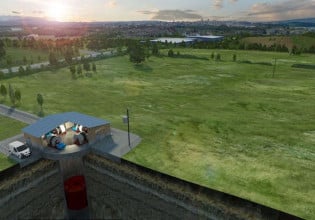EV Companies Join Forces for Vehicle Grid Integration
Recently, several automakers banded together to create a fast-charging network to challenge Tesla's Supercharger infrastructure. This article discusses their latest efforts.
BMW Group, Ford Motor Company, and American Honda Motor Co. are teaming up to create ChargeScape, LLC, an electric vehicle (EV) charging platform that will connect automakers, EV customers, and electric utilities into a single platform to serve the U.S. and Canada. This plan comes just weeks after these companies joined a collaboration of EV makers to create a charging network to rival Tesla’s SuperCharger technology.
BMW, Ford, and Honda have agreed to create ChargeScape, a company focused on optimizing electric vehicle grid services. Image used courtesy of Ford Motor Company
Open Vehicle-Grid Integration Platform (OVGIP) is a software application concept that has been around since 2012. The idea is to connect the different nodes that provide electrical energy to EVs while also allowing electric utilities to use the energy stored in EV batteries to manage the load on the power grid. Although the idea has been around for more than a decade, its implementation hasn’t taken place on any large scale.
The OVGIP application will be used to manage energy storage and usage over a growing number of EVs that are tied to the grid using a vehicle-to-grid (V2G) technology that many car makers are already including in their EVs.
Meeting Charging Demand
As more EVs enter the market, the demand on the electrical power grid will increase. At present, meeting peak energy demand (typically in the afternoon, during the hottest part of the day) is accomplished with natural gas-powered turbine generators or through battery energy storage systems (BESS) that can add electrical energy as needed to get past the peak demand. It has occurred to planners, however, that soon there will exist a vast fleet of EVs with fully charged batteries that could be tapped into to help meet peak electrical demand.
By sharing a small amount of the energy stored in their batteries, the EVs could be used to support grid resilience while also providing potential financial benefits to participating EV customers. That’s the concept behind ChargeScape.
Vehicle-to-grid using bidirectional charging infrastructure. Image used courtesy of Office of Technology Transitions
If ChargeScape can align EV charging with lower-cost off-peak hours and take advantage of renewable energy such as wind and solar, not only will EV customers reduce their operating costs, but they can also play a role in decarbonizing the electric power grid.
One of the goals of the single-platform ChargeScape concept is to seamlessly integrate each automotive brand and individual public utility so that grid operators will have a vast pool of EVs that supply electrical energy to the grid. The EV customer will always have control of charging and energy decisions. By using plugged-in EV batteries as an energy resource, peak demand can be met without the need to start peaker generators or pull from battery energy storage systems.
V2G: It’s Not All Roses
Although the V2G idea of using EVs as an energy source during peak demand is sound, it does have some issues. In general, each time an EV battery is charged and discharged, it is diminished by a tiny amount. Over a lifetime of 10 years or more than 100,000 miles, this degradation is acceptable, but if the power grid is also tapping into the EV battery, discharging it slightly, and recharging it, there will be some noticeable shortening of the overall life of the battery. This may be acceptable, but the EV owner should expect to be compensated financially for this wear and tear on the battery pack.
EV batteries degrade over time. Image used courtesy of NREL
Customers may also resist the idea that their EV may be drained by a power company and not be ready to be used at a moment's notice. Producing data on when the EV is in use and when it is dormant is pretty easy, and while most people live fairly predictable lives, they hate to admit that and may believe that they might want to jump into their cars and go somewhere in the middle of the night.
Another limiting factor is for V2G to work, the EV must be plugged into a charger. This works fine if connected to a Level 2 home charger in a household with Smart metering that can adjust to different electricity rates, but isn’t practical for EVs that are unplugged in a parking lot all day, or while traveling.
More to Come
BMW, Ford, and Honda have kicked off the ChargeScape plan but are hoping that other automakers will join their efforts. The plan, depending upon regulatory approvals, is to have the system operational in 2024.









